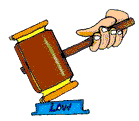All of the laws in this country originate from England. Thankfully, many of the laws we have today are much kinder then when they were first originated. In early medieval Europe and England, disputed criminal charges were often decided by what was called back then an ordeal. In a trial by fire, the accused person would have to either place his or her hand in boiling water, or have a red hot piece of iron laid in his or her open hand causing a major wound. If the wound did not heal properly, that meant the person was guilty. This was based on the principle of divine intervention and the belief that divine forces would not allow an innocent person to be harmed.
 In a trial by combat, the defendant could challenge his accuser to a duel, with the outcome determining the legitimacy of the accusation. However, the accuser had the option of finding an alternate to fight in his place. It was possible to acquire a “champion” to fight for you if the trial was one-sided. This evened the odds for you a bit.
In a trial by combat, the defendant could challenge his accuser to a duel, with the outcome determining the legitimacy of the accusation. However, the accuser had the option of finding an alternate to fight in his place. It was possible to acquire a “champion” to fight for you if the trial was one-sided. This evened the odds for you a bit.
Despite such reforms, the system of crime, punishment, law, and justices were chaotic. The lords of the great manors, who tried cases according to the local customs and rules, controlled the law. Although people generally agreed that such acts as theft, assault, treason, and blasphemy constituted crimes, the penalties were often arbitrary, discretionary, and very cruel. Public punishments were flogging, branding, beheading, with the head stuck on a stake to be witnessed by all, and burning, usually tied to a stake and still alive.
Settling trials by ordeal fell out of favor when the Catholic Church, at the Fourth Lateran Council in 1215, said that priests could no longer participate in trials by ordeal in disputed criminal cases, courts both in England and in the rest of Europe were not sure how to proceed. In England, the Church ban on ordeal meant that a new method of deciding criminal trials needed to be developed.
To fill in the gap, British justices adapted a method that had long been used to determine real estate taxes. Since the time of William the Conqueror, 12 knights in each district had been called before an inquest of the king’s justices to give local tax information, (early IRS tax men). Instead of the slow determination of taxes by judges, these twelve free and lawful men of the neighborhood would view the land and testify as to who last had peaceful possession so that an accurate accounting could be made. Since they were available when the king’s justices were present on circuit, the Writ of Novel Disseisin, first established in 1166 under Henry II, also required them to settle claim jumping disputes over land.
By 1219, the jury (which is from the Latin term jurati, to be sworn), called to decide land cases also began to hear criminal cases. The first jurors were like witnesses, telling the judge what they knew about the case; these courts were known as assise or assize (from the Latin assideo, to sit together). By the fourteenth century jurors had become the deciders of fact. The very first case that established the principle of jury trials was the Bushell’s case in 1670. A London jury acquitted William Penn, a leading Quaker and later the founder of Pennsylvania, of unlawful assembly in connection with his preaching in the street after the Quaker church was padlocked.